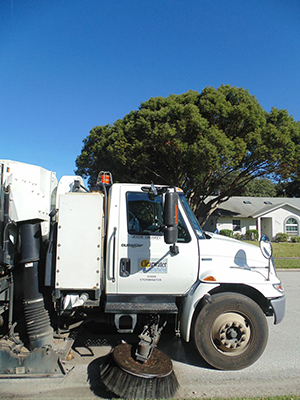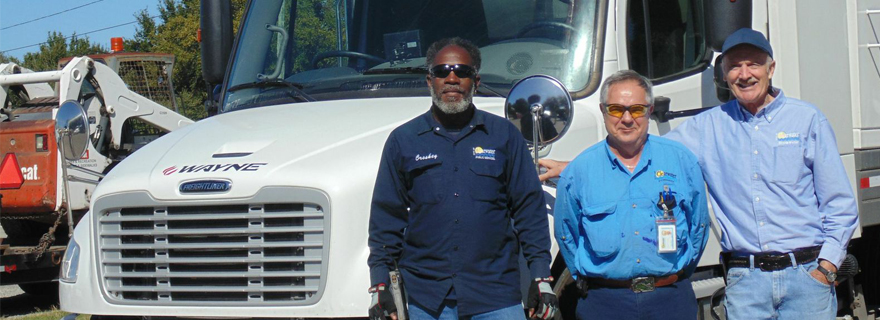Photo by Victoria Parsons.[/su_pullquote]
Riding high above the road at just seven miles per hour in a street sweeper, it’s easy for Jessie Croskey to identify homeowners who are breaking the law.
Small pockets of leaves and grass clippings naturally accumulate in the low areas of heavily treed Clearwater neighborhoods, but they’re clearly more dense in areas where homeowners blow yard waste into the street instead of back into their yards.
“Most people don’t realize what they’re doing when they blow their grass clippings into the street,” he says. “That yard waste washes into inlets and then to the beach or the bay, where it pollutes the water that attracts tourists and keeps our whole economy going.”
The City of Clearwater is so convinced that stormwater pollution can be stopped close to its source that it has committed to sweeping every street in its boundaries at least once a month – with beachside streets and parking lots swept three times a week. “We don’t always make that schedule, depending upon other events, but that’s the goal,” says Melvin Maciolek, stormwater maintenance manager.
Four sweepers — which cost about $250,000 each — run eight-hour shifts through neighborhoods identified with color-coded grids to ensure that every street is swept on schedule. The machines function like giant vacuum cleaners with high-pressure sprayers that break sediment loose, gutter brooms to sweep it up and a vacuum that sucks debris into a giant hopper. During “leaf season” in the fall, Croskey can collect about five cubic yards of yard waste —equal to about 65 bags of mulch — in about 30 minutes.
“We fill up faster with leaves than normal debris,” Croskey notes. “A lot of people think we’re out here so their neighborhoods look cleaner, but our top priority is preventing pollution. Street sweepers are the first defense against water pollution.”

Photo by Victoria Parsons
“Illegal” lawns stand out
Cruising a “hot spot” with dense tree canopy early one October morning, Croskey points out the perfectly manicured lawn on a corner lot, surrounded by a thick layer of leaves and grass clippings clogging the gutter ad overflowing into the street. “You can tell who follows the law and who doesn’t,” he says.
Although county regulations make it illegal to blow yard waste into the street — with fines of up to $500 for repeat offenders — preventing pollution from yard waste is more an educational effort than a law-enforcement initiative, Maciolek said. “All our drivers have door hangers and brochures to give residents, but they don’t have the power to ticket someone who is breaking the law.”
New regulations that require lawn care companies to complete classes on environmental issues have cut down the amount of yard waste blown into streets, Croskey adds. “Mostly what we see now is homeowners who don’t know about the rules.”
While street sweeping is much more cost effective than other methods of capturing nutrients once they’ve been released, it’s not an inexpensive process. According to a 2011 report from the University of Florida and the Florida Stormwater Association, it costs about $165 per pound to recover nitrogen using street sweepers.
However, once leaves and grass clippings escape gutters and end up in nearby catch basins, the cost jumps to $1016 per pound. That compares to $935 for a “treatment train” that begins with a retention pond and goes up to $14,800 per pound for sophisticated systems that separate nutrients from stormwater.
The Florida Department of Environmental Protection estimates an average cost of $9,800 per pound to recapture nitrogen after it has been swept away in stormwater. To put that number in context, a study from the University of Connecticut shows that grass clippings contain about 4% nitrogen, 0.5% phosphate and 2% potassium – and that leaving grass clippings on the lawn adds nearly two pounds of nitrogen to each 1,000 square feet of lawn.
In other words, instead of local governments shelling out anywhere from $330 to nearly $30,000 to treat and remove the two pounds of nitrogen contained in 50 pounds of lawn clippings, homeowners can save money on fertilizer by blowing that same yard waste back on to the lawn.
Nitrogen and other nutrients are considered the most damaging pollutant in Tampa Bay and most surface waters across the U.S. While necessary for life, nutrients can also fuel the growth of algae in marine environments. Too much algae clouds the water, blocking sunlight from seagrasses that provide critical habitat for valuable fish and shellfish. Then when the algae die, they absorb oxygen that other creatures need to survive.
In Tampa Bay and other communities across Florida, nitrogen levels in surface waters are strictly regulated by the U.S. Environmental Protection Agency. “As it stands now, local governments are not allowed to increase the levels of nitrogen released to surface waters – which is relatively easy as long as our communities don’t continue to grow,” said Maya Burke, senior environmental planner for the Tampa Bay Regional Planning Council. “The problem begins to occur when new subdivisions and shopping centers increase the amount of nitrogen coming off what is now undeveloped land. And if we can’t continue to grow, our entire economy will stagnate, and that won’t be good for anyone.”
[su_divider]